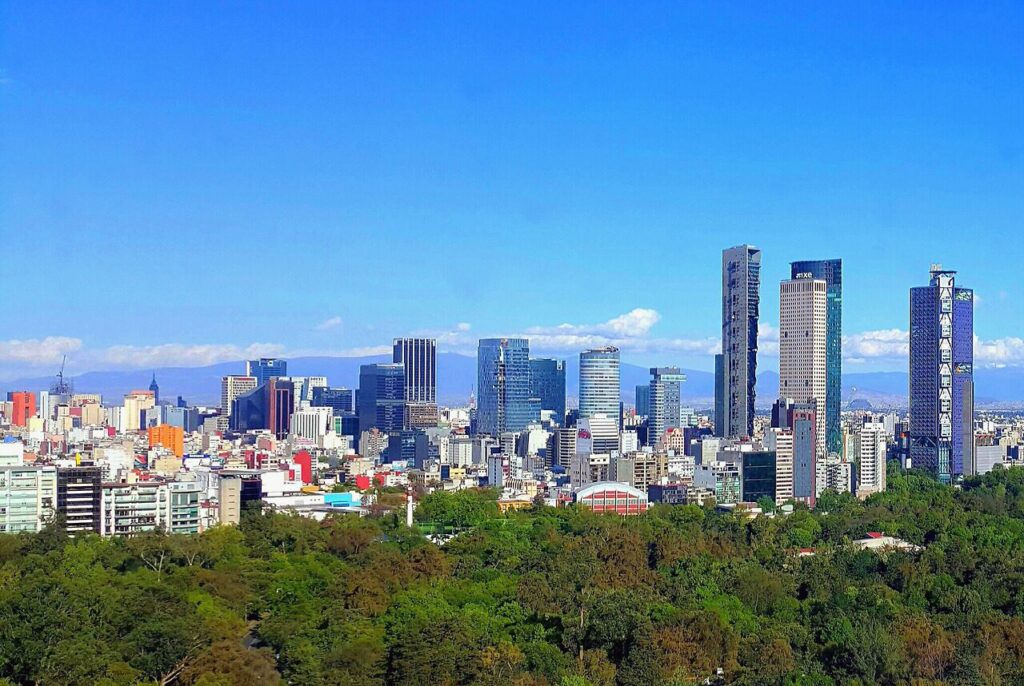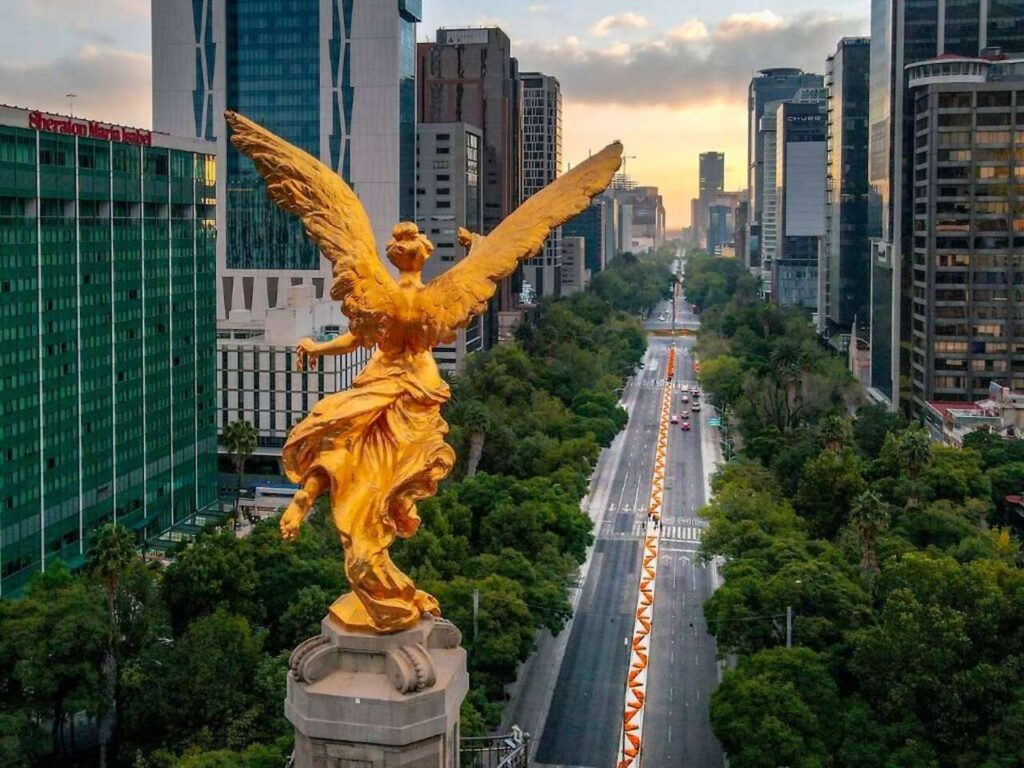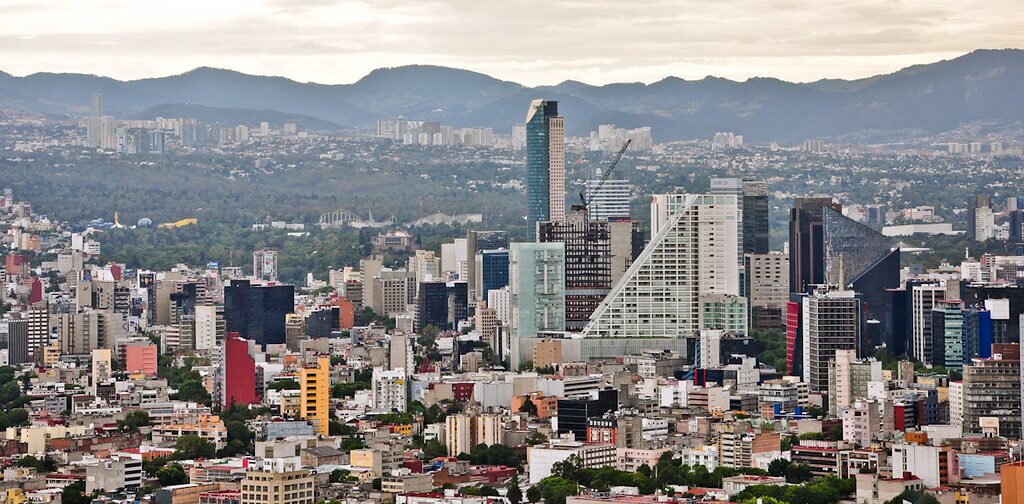
Mexico City (Ciudad de México) is a megacity where history and modernity coexist.
1. City Overview
- Population: The Greater Metropolitan Area’s population is estimated to be approximately 22.75 million in 2025. The city proper had about 9.21 million inhabitants in 2020.
- Area: The city proper covers approximately 1,495 km². The Greater Metropolitan Area extends across the broader Valley of Mexico.
- Languages: The official language is Spanish (Mexican standard). Other languages spoken include Nahuatl and other indigenous languages, with some English use.
- Religion: Catholicism is predominant, but Protestantism, irreligion, and minority indigenous faiths also exist.
- Climate: Located in a high-altitude area (approximately 2,240m), the city experiences an average annual temperature of 15–18°C with a dry highland climate.
2. History
- Aztec Capital Tenochtitlan (~1521): Originally an island city on a lake, Tenochtitlan grew into the heart of the Aztec Empire.
- Spanish Conquest Period (~1521–16th Century): In 1521, the Spanish conquered and rebuilt the city as Mexico City (Ciudad de México), reshaping it into the political and religious center of Spanish colonial rule.
- Independence and Modernization (~19–20th Century): Mexico City remained the capital after Mexico’s independence in 1821. In 1987, the Centro Histórico was designated a UNESCO World Heritage site.
- Transition to Megacity (~Late 20th Century–Present): After the major earthquake in 1985, the city underwent restoration. However, rapid urbanization and population growth have led to issues like the “sinking city” phenomenon and groundwater depletion.

3. Geography
- Location and Altitude: Mexico City is located on the central plateau of the Valley of Mexico at an altitude of approximately 2,240m.
- Valley of Mexico: This valley was once composed of five lakes, but excessive drainage has led to groundwater depletion and ground subsidence.
- Urban Structure: The city includes the Centro Histórico (historic center), bohemian and trendy areas like Roma and Condesa, and new urban districts such as Santa Fe and Polanco.
4. Culture
- Multicultural Art Hub: Mexico City has produced renowned artists like Frida Kahlo and Diego Rivera. Cultural spaces are centered around the Palacio de Bellas Artes and the Museo de Arte Moderno.
- Food Culture: Known for traditional Mexican dishes such as tacos, and unique Mexico City specialties like Mole and Quesadilla, it has become a top street food destination in the Spanish-speaking world.
- Festivals: The city hosts vibrant festivals, including the Día de Muertos (Day of the Dead) parade, Lucha Libre (wrestling), and various popular music and street art parades.
5. Environment
- Ground Subsidence: The city is known as a “sinking city,” subsiding by tens of centimeters annually.
- Air and Water Quality Issues: Over-extraction of groundwater causes urban subsidence, and aging infrastructure contributes to drought and water scarcity, posing a “Day Zero” risk.
- Response Efforts: Efforts include improving water supply systems, using water tanks, and providing emergency water supplies, though some areas still face water shortages.

6. Economy
- Political and Financial Center: Mexico City serves as the governmental and financial hub of Mexico. Its Greater Metropolitan Area produces approximately US$411 billion in GDP, accounting for about 17% of the national GDP.
- Industrial Structure Transformation: The city transitioned from an industrial center in the 1970s to a service-oriented economy, primarily focused on finance and information technology.
- Employment and Migration: Large-scale migration from rural to urban areas has led to the formation of informal settlements.
7. Key Locations
- Historic Center (Centro Histórico):
- Zócalo: Latin America’s largest square, bordered by the Metropolitan Cathedral and the National Palace.
- Templo Mayor: Ruins of an Aztec temple.
- Palacio de Bellas Artes: A central hub for music and art.
- Art and Cultural Districts:
- Roma & Condesa: Known for their bohemian culture and cafes.
- Chapultepec Park: A central park containing museums and a castle, serving as a recreational area for citizens.
- Modern Economic Districts:
- Santa Fe & Polanco: Feature modern skylines and host headquarters of foreign companies.
- REFORMA Street: An iconic financial and cultural street.

8. Conclusion
Mexico City has undergone a dramatic transformation from the heart of the Aztec civilization to a modern megacity.
- Strengths: Rich historical legacy from Tenochtitlan and the colonial era, deep cultural heritage with diverse arts, festivals, and cuisine, and significant economic influence as a hub for Latin American economic institutions.
- Challenges: Ground subsidence, water shortages, air pollution, and housing issues are major challenges.
- Future Strategy: Future strategies include sustainable water management and public transportation. They also involve protecting historic areas, expanding smart infrastructure, urban regeneration centered on arts and culture, and improving water infrastructure.
